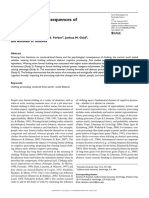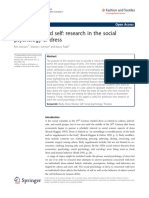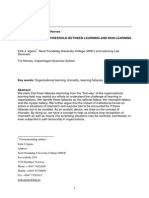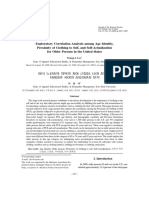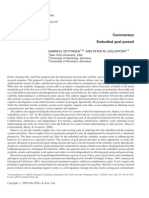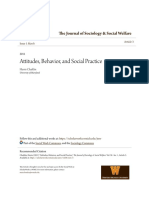Enclothed Cognition
Enclothed Cognition
Uploaded by
alwaysbored144Copyright:
Available Formats
Enclothed Cognition
Enclothed Cognition
Uploaded by
alwaysbored144Copyright
Available Formats
Share this document
Did you find this document useful?
Is this content inappropriate?
Copyright:
Available Formats
Enclothed Cognition
Enclothed Cognition
Uploaded by
alwaysbored144Copyright:
Available Formats
YJESP-02834; No.
of pages: 8; 4C:
Journal of Experimental Social Psychology xxx (2012) xxxxxx
Contents lists available at SciVerse ScienceDirect
Journal of Experimental Social Psychology
journal homepage: www.elsevier.com/locate/jesp
Reports
Enclothed cognition
Hajo Adam, Adam D. Galinsky
Northwestern University, Evanston, IL 60208, USA
a r t i c l e
i n f o
a b s t r a c t
We introduce the term enclothed cognition to describe the systematic inuence that clothes have on the wearer's psychological processes. We offer a potentially unifying framework to integrate past ndings and capture the diverse impact that clothes can have on the wearer by proposing that enclothed cognition involves the co-occurrence of two independent factorsthe symbolic meaning of the clothes and the physical experience of wearing them. As a rst test of our enclothed cognition perspective, the current research explored the effects of wearing a lab coat. A pretest found that a lab coat is generally associated with attentiveness and carefulness. We therefore predicted that wearing a lab coat would increase performance on attention-related tasks. In Experiment 1, physically wearing a lab coat increased selective attention compared to not wearing a lab coat. In Experiments 2 and 3, wearing a lab coat described as a doctor's coat increased sustained attention compared to wearing a lab coat described as a painter's coat, and compared to simply seeing or even identifying with a lab coat described as a doctor's coat. Thus, the current research suggests a basic principle of enclothed cognitionit depends on both the symbolic meaning and the physical experience of wearing the clothes. 2012 Elsevier Inc. All rights reserved.
Article history: Received 19 January 2012 Revised 7 February 2012 Available online xxxx Keywords: Embodied cognition Clothing Lab coat Attention
What a strange power there is in clothing. ~Isaac Bashevis Singer Nobel Prize winning author Isaac Bashevis Singer asserts that the clothes we wear hold considerable power and sway. In line with this assertion, bestselling books such as Dress for Success by John T. Molloy and TV shows like TLC's What Not to Wear emphasize the power that clothes can have over others by creating favorable impressions. Indeed, a host of research has documented the effects that people's clothes have on the perceptions and reactions of others. High school students' clothing styles inuence perceptions of academic prowess among peers and teachers (Behling & Williams, 1991). Teaching assistants who wear formal clothes are perceived as more intelligent, but as less interesting than teaching assistants who wear less formal clothes (Morris, Gorham, Cohen, & Huffman, 1996). When women dress in a masculine fashion during a recruitment interview, they are more likely to be hired (Forsythe, 1990), and when they dress sexily in prestigious jobs, they are perceived as less competent (Glick, Larsen, Johnson, & Branstiter, 2005). Clients are more likely to return to formally dressed therapists than to casually dressed therapists (Dacy & Brodsky, 1992). And appropriately dressed customer service agents
Corresponding author at: Northwestern University, 2001 Sheridan Road, Evanston, IL 60208, USA. Fax: + 1 847 491 8896. E-mail address: agalinsky@kellogg.northwestern.edu (A.D. Galinsky). 0022-1031/$ see front matter 2012 Elsevier Inc. All rights reserved. doi:10.1016/j.jesp.2012.02.008
elicit stronger purchase intentions than inappropriately dressed ones (Shao, Baker, & Wagner, 2004). Yet, the clothes we wear have power not only over others, but also over ourselves. Although identity scholars have long theorized that wearing clothes means assuming a particular identity that elicits corresponding behaviors from the wearer (Stone, 1962), this second facet of the power of clothing has received far less attention in scholarly work. Indeed, research on the effects of clothing on people's own perceptions and behavior is relatively scattered and disintegrated. Most of this research has focused on the deindividuating effects of clothes, but this literature has not always produced consistent effects. For example, wearing large hoods and capes makes people more likely to administer electric shocks to others (Zimbardo, 1969), whereas wearing a nurse uniform makes people less likely to administer these shocks (Johnson & Downing, 1979), a contradiction that deindividuation scholars have been struggling to reconcile (Lea, Spears, & de Groot, 2001; Spears, 1995). Furthermore, from a color psychology perspective, research has shown that professional sports teams wearing black uniforms are more aggressive than sports teams wearing non-black uniforms (Frank & Gilovich, 1988). Finally, from a self-objectication perspective, research has found that wearing a bikini makes women feel ashamed, eat less, and perform worse at math (Fredrickson, Roberts, Noll, Quinn, & Twenge, 1998). We propose a potentially unifying framework to understand these past ndings and to parsimoniously capture the impact of clothing on the wearer's perceptions and actions. Specically, drawing from research on embodied cognition, we introduce the term
Please cite this article as: Adam, H., & Galinsky, A.D., Enclothed cognition, Journal of Experimental Social Psychology (2012), doi:10.1016/ j.jesp.2012.02.008
H. Adam, A.D. Galinsky / Journal of Experimental Social Psychology xxx (2012) xxxxxx
enclothed cognition to designate the systematic inuence of clothes on the wearer's psychological processes and behavioral tendencies. Enclothed cognition Traditional theories of cognition argue that cognitive representations are based on amodal, abstract content. In contrast, theories of embodied cognition (e.g., Barsalou, 1999, 2008; Glenberg, 1997; Niedenthal, Barsalou, Winkielman, Krauth-Gruber, & Ric, 2005) argue that cognitive representations are based on modal, perceptual content that is based in the brain's sensory systems for perception (e.g., vision, audition), action (e.g., movement, proprioception), and introspection (e.g., mental states, affect). As physical experiences become schematized into multimodal representations stored in memory, these physical experiences form an integral part in shaping cognitive representations of abstract concepts and acquire symbolic meaning. Thus, physical experiences can trigger associated abstract concepts and mental simulation through this symbolic meaning. An increasing amount of research supports the embodied cognition perspective: for example, the physical experience of cleansing oneself is associated with the abstract concept of moral purity (Zhong & Liljenquist, 2006). Because of this symbolic meaning, it has been shown that physical cleansing inuences judgments of morality (Schnall, Benton, & Harvey, 2008). In a similar vein, experiencing physical warmth increases feelings of interpersonal warmth (Williams & Bargh, 2008), walking slowly activates the stereotype of the elderly (Mussweiler, 2006), nodding one's head while listening to a persuasive message increases one's susceptibility to persuasion (Wells & Petty, 1980), holding a pen in the mouth in a way that activates the muscles associated with smiling leads to more intense humor responses (Strack, Martin, & Stepper, 1988), carrying a heavy clipboard increases judgments of importance (Jostman, Lakens, & Schubert, 2009), clean scents increase the tendency to reciprocate trust and to offer charitable help (Liljenquist, Zhong, & Galinsky, 2010), and adopting an expansive body posture affects one's sense of power and associated action tendencies more so than being in a powerful role (Huang, Galinsky, Gruenfeld, & Guilory, 2011). We argue that just like physical experiences, the experience of wearing clothes triggers associated abstract concepts and their symbolic meanings. In particular, we posit that wearing clothes causes people to embody the clothing and its symbolic meaning. Consequently, when a piece of clothing is worn, it exerts an inuence on the wearer's psychological processes by activating associated abstract concepts through its symbolic meaningsimilar to the way in which a physical experience, which is, by denition, already embodied, exerts its inuence. Although embodied cognition and enclothed cognition thus operate in similar ways, there is an important difference. In embodied cognition, the link between a physical experience and its symbolic meaning is direct, as it is the physical experience itself that carries the symbolic meaning. In other words, the symbolic meaning is always automatically embodied because it directly stems from the physical experience. In enclothed cognition, the link between a physical experience and its symbolic meaning is indirect, as it is the clothes that carry the symbolic meaning. In other words, the symbolic meaning is not automatically embodied because it stems from the clothesso it is not realized until one physically wears and thus embodies the clothes. This distinction between embodied cognition and enclothed cognition indicates that enclothed cognition involves the co-occurrence of two independent factors: the symbolic meaning of the clothes and the physical experience of wearing the clothes. Hence, we propose a basic principle of enclothed cognitionthe effects of clothing
on people's psychological processes depend on both a) the symbolic meaning of the clothes and b) whether people are actually wearing the clothes. Overall, we hypothesize that wearing a piece of clothing and embodying its symbolic meaning will trigger associated psychological processes. It should be noted that there is an important distinction to be made between enclothed cognition and material priming effects. Material priming refers to the phenomenon that simply being exposed to a physical item (e.g., a boardroom table) can increase behaviors consistent with the symbolic meaning of that item (e.g., a competitive orientation) (Kay, Wheeler, Bargh, & Ross, 2004). We argue, however, that actually wearing a piece of clothing and having the accompanying physical experiences (e.g., seeing it on one's body, feeling it on one's skin, etc.) will make it signicantly more likely for the piece of clothing to inuence the wearer's psychological processes, above and beyond basic material priming effects. That is, embodying the clothing's symbolic meaning is a critical element in our enclothed cognition perspective. Our argument is consistent with work showing that people who take the perspective of a stereotyped group are signicantly more likely to display stereotype-consistent behaviors than people who are merely primed with a stereotyped group (Galinsky, Wang, & Ku, 2008). It is also consistent with research showing that embodying power by adopting an expansive body posture is signicantly more likely to inuence power-consistent action tendencies than merely priming power (Huang et al., 2011). Just as the effects of perspective-taking and embodied power are not reducible to a basic behavioral priming process, we propose that the effects of enclothed cognition are not reducible to simple material priming effects. Experimental overview In the current research, we tested our enclothed cognition perspective with respect to lab coats. Lab coats are the prototypical attire of scientists and doctors. Wearing a lab coat thus signies a scientic focus and an emphasis on being careful and attentive attributes that involve the importance of paying attention to the task at hand and not making errors. To conrm that people indeed associate a lab coat with attention-related concepts, we recruited 38 people (16 female, 22 male; average age: 36.47 years) from Amazon's Mechanical Turk website (see Buhrmeister, Kwang, & Gosling, 2011) to participate in a short online survey. Participants were shown a picture of a white lab coat similar to the one used in the experiments reported in this article. Participants rated the extent to which they associated the lab coat with attentiveness, carefulness, responsibility, and a scientic focus on a scale from 1 (not at all) to 5 (very much). An association was considered to exist if it was rated signicantly above the midpoint of the scale (see Galinsky & Moskowitz, 2000). Results conrmed that participants held strong associations between a lab coat and each of the attention-related constructs, all ts > 5.36, ps b .001. We thus hypothesized that wearing a lab coat increases performance on attentionrelated tasks. In the current research, we explored two dimensions of attention: selective attention and sustained attention. Selective attention is the ability to focus on relevant stimuli and ignore irrelevant ones, and sustained attention is the ability to maintain focus on a continuous activity (Davies, Jones, & Taylor, 1984). Experiment 1 tested whether wearing a lab coat inuences selective attention using a Stroop task (Stroop, 1935). Experiments 2 and 3 looked at sustained attention using a comparative visual search task (Pomplun, Reingold, & Shen, 2001). Across the experiments, we tested our core hypothesis that enclothed cognition depends on two independent factorsactually wearing the clothes and the symbolic meaning of the clothes. In
Please cite this article as: Adam, H., & Galinsky, A.D., Enclothed cognition, Journal of Experimental Social Psychology (2012), doi:10.1016/ j.jesp.2012.02.008
H. Adam, A.D. Galinsky / Journal of Experimental Social Psychology xxx (2012) xxxxxx
Experiment 1: physically wearing a lab coat Method Design and participants Fifty-eight undergraduates (41 females, 19 males; average age: 20.29 years) at a large university in the Midwestern United States participated in the experiment. They were randomly assigned to one of two conditions: wearing a lab coat vs. not wearing a lab coat. Procedure and experimental manipulation In the wearing-a-lab-coat condition, participants were asked to wear a disposable white lab coat. To provide a cover story, the experimenter told participants that other participants in prior sessions of this experiment had been wearing lab coats during lab construction. Although the construction had been completed, the experimenter told participants that they still needed to wear the lab coat so all participants in the experiment would be in the same situation. In the notwearing-a-lab-coat condition, participants completed the tasks in their own clothes. Dependent measure To measure selective attention, we administered a Stroop task (Stroop, 1935) and instructed participants to indicate as quickly and accurately as possible whether a series of letter strings was presented in red or blue on a computer screen. The task consisted of 50 trials: 20 incongruent trials in which the meaning of the letter string interfered with the task of naming the color (i.e., RED in blue or BLUE in red), and 30 non-incongruent trials in which the meaning of the letter string did not interfere with the task of naming the color (i.e., XXXX in red or blue, RED in red, or BLUE in blue). The order of trials was random. We measured whether participants indicated the right color as well as the time they took to complete each trial. Selective attention was assessed by contrasting performance on incongruent trials (which tested the ability to focus on relevant stimuli while ignoring irrelevant stimuli) with performance on non-incongruent trials (e.g., Smith, Jostmann, Galinsky, & Van Dijk, 2008). Results We entered error rates in the Stroop task into a 2 (lab coat: lab coat vs. no lab coat) x 2 (trial type: incongruent vs. nonincongruent) mixed-model ANOVA, with the second factor withinsubjects. Indicating a Stroop effect, participants made more errors on incongruent trials than on neutral trials, F(1, 57) = 19.75, p b .001; 2p = .26. Consistent with our hypothesis, this effect was moderated by a signicant interaction effect, F(1, 57) = 5.42, p = .02; 2p = .09 (see Fig. 1). Participants in the wearing-a-labcoat condition made around half as many errors as participants in the not-wearing-a-lab-coat condition on incongruent trials, F(1, 57) = 4.33, p = .04; 2p = .07, but the same number of errors on non-incongruent trials, F b 1.19, p > .28. The time participants took to complete each trial did not vary across conditions, Fs b 0.32, ps > .57. Experiment 2: the importance of symbolic meaning The results of Experiment 1 demonstrate that wearing a lab coat leads to increased selective attention on a Stroop task. Although
Number of errors per trial
Experiment 1, we varied whether participants wore a lab coat. In Experiments 2 and 3, we varied whether participants wore a lab coat as well as the lab coat's symbolic meaning by describing it as a doctor's coat or as a painter's coat.
0.1
Not wearing a lab coat
0.08
Wearing a lab coat
0.06
0.04
0.02
0 Non-incongruent trials Incongruent trials
Fig. 1. Selective attention (number of errors per trial in the Stroop task) as a function of experimental condition and trial type. Error bars represent 1 SEM.
these results are highly consistent with our enclothed cognition perspective, our model proposes that enclothed cognition involves two components: physically wearing the clothes and the symbolic meaning of the clothes. In Experiment 1, the two components were confounded, and the second componentthe role of the symbolic meaning of the lab coatwas assumed rather than explicitly examined. The goal of Experiment 2 was to parse out these components and show that both wearing the clothes and the symbolic meaning of the clothes are collectively necessary conditions for enclothed cognition to occur. To test our full model, we manipulated the symbolic meaning of the lab coat by associating it with medical doctors or artistic painters (for whom paying close attention to the task and maintaining focus is not as important). Furthermore, to rule out that any effects would be driven by mere priming effects, and to show that it is essential to actually wear the lab coat, we also included a condition in which participants would see, but not wear, a lab coat associated with medical doctors. Finally, we wanted to complement Experiment 1 by examining another dimension of attention, namely sustained attention. We used a comparative visual search task that required participants to maintain focus on a continuous activity. Method Design and participants Seventy-four undergraduate students (47 female, 27 male; average age: 19.85 years) at a large university in the Midwestern United States participated in the experiment. They were randomly assigned to one of three conditions: wearing a doctor's coat vs. wearing a painter's coat vs. seeing a doctor's coat. Procedure and experimental manipulation In all conditions, participants were told that local ofcials across the United States are thinking about making certain clothes mandatory for certain professions in their municipalities, and one purpose of the experiment was to see what people think about the clothes. In the wearing-a-doctor's-coat condition, participants were asked to wear a disposable white lab coat described as a medical doctor's coat. In the wearing-a-painter's-coat condition, participants were asked to wear the same disposable white lab coat, but this time it was described as an artistic painter's coat. In the seeing-a-doctor's-coat condition, participants simply saw a disposable white lab coat described as a medical doctor's coat displayed on a table in the laboratory. In all conditions, participants
Please cite this article as: Adam, H., & Galinsky, A.D., Enclothed cognition, Journal of Experimental Social Psychology (2012), doi:10.1016/ j.jesp.2012.02.008
H. Adam, A.D. Galinsky / Journal of Experimental Social Psychology xxx (2012) xxxxxx
answered questions about the coat (e.g., how the coat would look on doctors/painters) before proceeding to the sustained attention task. Dependent measure To measure sustained attention, we administered four comparative visual search tasks (e.g., Pomplun et al., 2001). Each task displayed two pictures next to each other on a computer screen. The pictures were identical except for four minor differences (see Appendix). For each pair of pictures, participants were told that there were four differences, and they were instructed to write down as quickly as possible as many differences as they could nd. We measured the number of differences participants found as well as the time they took to complete all tasks. Sustained attention was assessed by adding the number of differences participants found across the four tasks. Results We submitted the number of differences found to a one-way ANOVA, which yielded a signicant main effect for experimental condition, F(1, 73) = 4.34, p = .02; 2p = .11 (see Fig. 2). Consistent with our hypothesis, participants in the wearing-a-doctor's-coat condition found more differences than participants in the wearinga-painter's-coat condition, F(1, 51) = 7.03, p = .01; 2p = .12, and participants in the seeing-a-doctor's-coat condition, F(1, 46) = 6.65, p = .01; 2p = .13 The number of differences found did not vary across the latter two conditions, F b 0.02, p > .91. The time participants took to complete all tasks did not vary across conditions, F b 0.47, p > .63, demonstrating that the effects were not due to mere persistence but resulted from heightened attention during the task. Experiment 3: beyond mere exposure
One intriguing nding from Experiment 2 is that there was no difference in sustained attention between participants who wore a lab coat described as a painter's coat and participants who saw a lab coat described as a doctor's coat. This nding may appear surprising because research on behavioral priming suggests that being primed with a doctor's coat should result in an increase in sustained attention. One potential explanation for the lack of a typical priming effect is that the prime was not strong enough in the seeing-a-doctor's-coat condition: Participants only saw the lab coat displayed on a table when they entered the laboratory, but they did not see it during the remainder of the experiment. Indeed, many studies have found that the amount of exposure to a primed construct determines the strength of its effects (Bargh & Pietromonaco, 1982; Higgins, 1996). Hence, it is possible that the difference in sustained attention between the wearing-a-doctor'scoat condition and the seeing-a-doctor's-coat condition was not caused by wearing the coat per se, but by the difference in how long participants were exposed to the coat. In addition, wearing the lab coat involves both the physical experience of wearing the coat and the connection of the coat to the self. Hence, it is possible that the effect of wearing the lab coat on sustained attention was not caused by the physical experience of wearing the coat, but by establishing a connection between the self and the coat. The goal of Experiment 3 was to address these two issues and provide further evidence that the physical experience of wearing a piece of clothing has an effect above beyond being merely primed with it. We therefore included a condition in Experiment 3 in which participants did not wear a lab coat described as a doctor's coat, but they were still exposed to the lab coat for the same amount of time and they still created a connection between the self and the coat.
Method The results of Experiment 2 demonstrate that wearing a lab coat leads to increased sustained attention on a comparative visual search task and that this effect depends on both whether the clothes are worn and the symbolic meaning of the clothes: Participants displayed greater sustained attention only when wearing a lab coat described as a doctor's coat, but not when wearing a lab coat described as a painter's coat or when seeing a lab coat described as a doctor's coat. Design and participants Ninety-nine undergraduate students (62 females, 37 males; average age: 20.02 years) at a large university in the Midwestern United States participated in the experiment. They were randomly assigned to one of three conditions: wearing a doctor's coat vs. wearing a painter's coat vs. identifying with a doctor's coat.
13
13
Number of differences found
12
Number of differences found
Wearing a doctor's coat Seeing a doctor's coat Wearing a painter's coat
12
11
11
10
10
8 Wearing a doctor's coat Identifying with a doctor's coat Wearing a painter's coat
Fig. 2. Sustained attention (number of differences found in the comparative visual search tasks) as a function of experimental condition. Error bars represent 1 SEM.
Fig. 3. Sustained attention (number of differences found in the comparative visual search tasks) as a function of experimental condition. Error bars represent 1 SEM.
Please cite this article as: Adam, H., & Galinsky, A.D., Enclothed cognition, Journal of Experimental Social Psychology (2012), doi:10.1016/ j.jesp.2012.02.008
H. Adam, A.D. Galinsky / Journal of Experimental Social Psychology xxx (2012) xxxxxx
Procedure and experimental manipulation In all conditions, participants were told that local ofcials across the United States are thinking about making certain clothes mandatory for certain professions in their municipalities, and one purpose of the experiment was to see what people think about the clothes. In the wearing-a-doctor's-coat condition, participants were asked to wear a disposable white lab coat described as a medical doctor's coat. In the wearing-a-painter's-coat condition, participants were asked to wear the same disposable white lab coat, but this time it was described as an artistic painter's coat. In both conditions, participants were asked to write an essay about their thoughts on the coat (e.g., how the coat would look on doctors/painters). In the identifying-with-a-doctor's-coat condition, participants saw a disposable white lab coat described as a medical doctor's coat displayed on the desk in front of them throughout the entire experiment. In this condition, participants were asked to write an essay about how they identify with the coat (e.g., how the coat represents them and has a specic, personal meaning). Dependent measure The dependent measure was sustained attention, which was assessed in the same way as in Experiment 2. Results We submitted the number of differences found to a one-way ANOVA, which yielded a signicant main effect for experimental condition, F(1, 98) = 8.89, p b .001; 2p = .16 (see Fig. 3). Consistent with our hypothesis, participants in the wearing-a-doctor's-coat condition found more differences than participants in the identifying-with-adoctor's-coat condition, F(1, 67) = 4.60, p = .04; 2p = .07, who in turn found more differences than participants in the wearing-apainter's-coat condition, F(1, 63) = 4.48, p = .04; 2p = .07. As in Experiment 2, the time participants took to complete all tasks did not vary across conditions, F b 1.42, p > .24, demonstrating that the effects were not due to mere persistence but resulted from heightened attention during the task. Thus, identifying with the doctor's lab coat increased the level of sustained attention, consistent with a typical priming effect. However, consistent with our enclothed cognition perspective, wearing the coat when it was described as a doctor's coat had an effect over and above simply being exposed to and identifying with it. Discussion The current research provides initial support for our enclothed cognition perspective that clothes can have profound and systematic psychological and behavioral consequences for their wearers. In Experiment 1, participants who wore a lab coat displayed increased selective attention compared to participants who wore their regular clothes. In Experiments 2 and 3, we found robust evidence that this inuence of clothing depends on both whether the clothes are worn and the symbolic meaning of the clothes. When the coat was associated with a doctor but not worn, there was no increase in sustained attention. When the coat was worn but not associated with a doctor, there was no increase in sustained attention. Only when a) participants were wearing the coat and b) it was associated with a doctor did sustained attention increase. These results suggest a basic principle of enclothed cognition: It involves the co-occurrence of two independent factorsthe symbolic meaning of the clothes and the physical experience of wearing them. These ndings indicate that the effects of wearing a piece of clothing on the wearer's psychological processes cannot be reduced to a simple material priming process (Kay et al., 2004), and thus
they add important explanatory variance above and beyond material priming effects. Furthermore, the results of Experiment 3 suggest that the effects of wearing a piece of clothing cannot be reduced to the wearer simply feeling identied with the clothing. Instead, there seems to be something special about the physical experience of wearing a piece of clothing, and this experience constitutes a critical component of enclothed cognition. One open question, however, is whether enclothed cognition is different in kind or different in degree from a basic identication process. On the one hand, it is possible that wearing a piece of clothing is qualitatively different from identifying with a piece of clothing through other means (e.g., by writing about it or by imagining oneself in it). On the other hand, it is possible that wearing a piece of clothing is simply a more potent method of identifying with its symbolic meaning, and that explains why wearing a lab coat produced a stronger effect on sustained attention than being identied with it in Experiment 3. Our results open new directions within the growing research on embodied cognition. First, research on embodied cognition has mostly focused on what we think (i.e., judgments of morality, importance, or power), but the current research broadens the scope of outcome variables by examining how we think (i.e., attentional processes). Second, our enclothed cognition perspective allows for the explicit exploration of the importance of symbolic meanings in the relationship between physical experiences and cognitive processes. Because embodied cognition research looks at physical experiences that have inherent symbolic meanings, the role of symbolic meanings is typically assumed rather than explicitly examined. In enclothed cognition, however, the physical experience of wearing the clothes and the symbolic meaning of the clothes are two independent factors, which allowed us to keep the physical experience constant while manipulating the symbolic meaning. Indeed, in Experiments 2 and 3, participants who wore a supposed doctor's coat and participants who wore a supposed painter's coat were in fact wearing the same coat and had the same physical experience, yet, their performance on an attention-related task differed depending on the coat's symbolic meaning. The current research thus provides the rst explicit evidence for the vital role of symbolic meanings in the inuence of physical experiences on cognitive processes. Beyond contributing to research on embodied cognition, we believe that an enclothed cognition perspective can provide a parsimonious and potentially unifying explanation for the scattered ndings on the effects of clothing found in the literature. For example, people who wear nurse uniforms maybe be less likely to administer electric shocks because wearing a nurse uniform might trigger associated concepts of caring and altruistic behavior. In contrast, people who wear large hoods may be more likely to administer electric shocks because wearing a large hood or other types of identity-concealing clothes might conjure up images of robbers, terrorists, and aggressive or deviant behaviors. An enclothed cognition perspective has the potential not only to explain and extend prior research ndings, but also to stimulate future research on the impact of clothing on cognitive processes. Does wearing the robe of a priest or judge make people more ethical? Does putting on an expensive suit make people feel more powerful? Does putting on the uniform of a reghter or police ofcer make people act more courageously? And, perhaps even more interestingly, do the effects of physically wearing a particular form of clothing wear off over time as people become habituated to it? Answering these kinds of questions would further elucidate how a seemingly trivial, yet ubiquitous item like an article of clothing can inuence how we think, feel, and act. Although the saying goes that clothes do not make the man, our results suggest that they do hold a strange power over their wearers.
Please cite this article as: Adam, H., & Galinsky, A.D., Enclothed cognition, Journal of Experimental Social Psychology (2012), doi:10.1016/ j.jesp.2012.02.008
H. Adam, A.D. Galinsky / Journal of Experimental Social Psychology xxx (2012) xxxxxx
Appendix
Please cite this article as: Adam, H., & Galinsky, A.D., Enclothed cognition, Journal of Experimental Social Psychology (2012), doi:10.1016/ j.jesp.2012.02.008
H. Adam, A.D. Galinsky / Journal of Experimental Social Psychology xxx (2012) xxxxxx
References
Bargh, J. A., & Pietromonaco, E. (1982). Automatic information processing and social perception: The inuence of trait information presented outside of conscious awareness on impression formation. Journal of Personality and Social Psychology, 43, 437449. Barsalou, L. W. (1999). Perceptual symbol systems. The Behavioral and Brain Sciences, 22, 577609. Barsalou, L. W. (2008). Grounded cognition. Annual Review of Psychology, 59, 617645. Behling, D. U., & Williams, E. A. (1991). Inuence of dress on perception of intelligence and expectations of scholastic achievement. Clothing and Textiles Research Journal, 9, 17. Buhrmeister, M. D., Kwang, T., & Gosling, S. D. (2011). Amazon's Mechanical Turk: A new source of inexpensive, yet high-quality, data? Perspectives on Psychological Science, 6, 35. Dacy, J. M., & Brodsky, S. L. (1992). Effects of therapist attire and gender. Psychotherapy, 29, 486490. Davies, D. R., Jones, D. M., & Taylor, A. (1984). Selective and sustained-attention tasks: Individual and group differences. In R. Parasuraman, R. Davies, & J. Beatty (Eds.), Varieties of attention (pp. 395447). New York: Academic Press. Forsythe, S. M. (1990). Effect of applicant's clothing on interviewer's decision to hire. Journal of Applied Social Psychology, 20, 15791595. Frank, M. G., & Gilovich, T. (1988). The dark side of self and social perception: Black uniforms and aggression in professional sports. Journal of Personality and Social Psychology, 54, 7485. Fredrickson, B. L., Roberts, T., Noll, S. M., Quinn, D. M., & Twenge, J. M. (1998). That swimsuit becomes you: Sex differences in self-objectication, restrained eating and math performance. Journal of Personality and Social Psychology, 75, 269284.
Galinsky, A. D., & Moskowitz, G. B. (2000). Perspective-taking: Decreasing stereotype expression, stereotype accessibility, and in-group favoritism. Journal of Personality and Social Psychology, 78, 708724. Galinsky, A. D., Wang, C. S., & Ku, G. (2008). Perspective-takers behave more stereotypically. Journal of Personality and Social Psychology, 95, 404419. Glenberg, A. M. (1997). What memory is for. The Behavioral and Brain Sciences, 20, 155. Glick, S., Larsen, S., Johnson, C., & Branstiter, H. (2005). Evaluations of sexy women in low and high-status jobs. Psychology of Women Quarterly, 29, 389395. Higgins, E. T. (1996). Knowledge activation: Accessibility, applicability and salience. In E. T. Higgins, & A. W. Kruglanski (Eds.), Social psychology: Handbook of basic principles (pp. 133168). New York: Guilford. Huang, L., Galinsky, A. D., Gruenfeld, D. H., & Guillory, L. E. (2011). Powerful postures versus powerful roles: Which is the proximate correlate of thought and behavior? Psychological Science, 22, 95102. Johnson, R. D., & Downing, L. L. (1979). Deindividuation and valence of cues: Effects on prosocial and antisocial behavior. Journal of Personality and Social Psychology, 37, 15321538. Jostman, N. B., Lakens, D., & Schubert, T. W. (2009). Weight as an embodiment of importance. Psychological Science, 20, 11691174. Kay, A. C., Wheeler, S. C., Bargh, J. A., & Ross, L. (2004). Material priming: The inuence of mundane physical objects on situational construal and competitive behavioral choice. Organizational Behavior and Human Decision Processes, 95, 8396. Lea, M., Spears, R., & de Groot, D. (2001). Knowing me, knowing you: Anonymity effects on social identity processes within groups. Personality and Social Psychology Bulletin, 27, 526537.
Please cite this article as: Adam, H., & Galinsky, A.D., Enclothed cognition, Journal of Experimental Social Psychology (2012), doi:10.1016/ j.jesp.2012.02.008
H. Adam, A.D. Galinsky / Journal of Experimental Social Psychology xxx (2012) xxxxxx Spears, R. (1995). Deindividuation. In A. S. R. Manstead, M. Hewstone, S. T. Fiske, M. A. Hogg, H. T. Reis, & G. R. Semin (Eds.), The Blackwell encyclopedia of social psychology (pp. 173175). Cambridge, Mass: Blackwell Publishing. Stone, G. P. (1962). Appearance and the self. In A. M. Rose (Ed.), Human behavior and social process (pp. 86118). Boston: Houghton Mifin. Strack, F., Martin, L. L., & Stepper, S. (1988). Inhibiting and facilitating conditions of the human smile: A nonobtrusive test of the facial feedback hypothesis. Journal of Personality and Social Psychology, 54, 768777. Stroop, J. R. (1935). Studies of interference in serial verbal reaction. Journal of Experimental Psychology, 18, 643662. Wells, G. L., & Petty, R. E. (1980). The effects of overt head movements on persuasion: Compatibility and incompatibility of responses. Basic and Applied Social Psychology, 1, 219230. Williams, L. E., & Bargh, J. A. (2008). Experiencing physical warmth promotes interpersonal warmth. Science, 322, 606607. Zhong, C. -B., & Liljenquist, K. (2006). Washing away your sins: Threatened morality and physical cleansing. Science, 313, 14511452. Zimbardo, P. G. (1969). The human choice: Individuation, reason, and order vs. deindividuation, impulse and chaos. In W. J. Arnold, & D. Levine (Eds.), Nebraska symposium on motivation, Vol. 17. (pp. 237307)Lincoln: University of Nebraska Press.
Liljenquist, K., Zhong, C. -B., & Galinsky, A. D. (2010). The smell of virtue: Clean scents promote reciprocity and charity. Psychological Science, 21, 381383. Morris, T. L., Gorham, J., Cohen, S. H., & Huffman, D. (1996). Fashion in the classroom: Effects of attire on student perceptions of instructors in college classes. Communication Education, 45, 135148. Mussweiler, T. (2006). Doing is for thinking! Stereotype activation by stereotypic movements. Psychological Science, 17, 1721. Niedenthal, P. M., Barsalou, L. W., Winkielman, P., Krauth-Gruber, S., & Ric, F. (2005). Embodiment in attitudes, social perception, and emotion. Personality and Social Psychology Review, 9, 184211. Pomplun, M., Reingold, E. M., & Shen, J. (2001). Investigating the visual span in comparative search: The effects of task difculty and divided attention. Cognition, 81, B57B67. Schnall, S., Benton, J., & Harvey, S. (2008). With a clean conscience: Cleanliness reduces the severity of moral judgments. Psychological Science, 19, 12191222. Shao, C. Y., Baker, J., & Wagner, J. A. (2004). The effects of appropriateness of service contact personnel dress on customer expectations of service quality and purchase intention: The moderating inuences of involvement and gender. Journal of Business Research, 57, 11641176. Smith, P. K., Jostmann, N. B., Galinsky, A. D., & Van Dijk, W. W. (2008). Lacking power impairs executive functions. Psychological Science, 19, 351398.
Please cite this article as: Adam, H., & Galinsky, A.D., Enclothed cognition, Journal of Experimental Social Psychology (2012), doi:10.1016/ j.jesp.2012.02.008
You might also like
- Enclothed Cognition ArticleDocument8 pagesEnclothed Cognition ArticlelloydmofNo ratings yet
- The Social Psychology of Dress Author Kim K.P. Johnson, Sharon LennonDocument9 pagesThe Social Psychology of Dress Author Kim K.P. Johnson, Sharon LennonClara IrenaNo ratings yet
- Dress Practices Throughout History Were Developed For Three Primary ReasonsDocument2 pagesDress Practices Throughout History Were Developed For Three Primary Reasonsjemal0% (1)
- Social Psychology of Fashion Assignment by Mudassar AfzalDocument8 pagesSocial Psychology of Fashion Assignment by Mudassar AfzalMUDASSAR AFZAL100% (1)
- School Uniforms Research ArticlesDocument4 pagesSchool Uniforms Research ArticlesMay ThweNo ratings yet
- The Cognitive Consequences of Formal ClothingDocument8 pagesThe Cognitive Consequences of Formal Clothingblejan carmenNo ratings yet
- Clothing As Communication Angerosa Thesis PDFDocument53 pagesClothing As Communication Angerosa Thesis PDFkomalNo ratings yet
- Clothing and Self EsteemDocument54 pagesClothing and Self EsteemjemalNo ratings yet
- Does Attire Influence The School System?Document12 pagesDoes Attire Influence The School System?api-304514782No ratings yet
- Stone - A Self Standards Model of Cognitive DissonanceDocument16 pagesStone - A Self Standards Model of Cognitive DissonanceSabinaNo ratings yet
- Catwalk 2Document28 pagesCatwalk 2Bambang IrawanNo ratings yet
- Social Psychology of DressDocument24 pagesSocial Psychology of DressKaushik RK50% (2)
- Mundane Consumption and The Self: A Social-Identity PerspectiveDocument27 pagesMundane Consumption and The Self: A Social-Identity PerspectiveDana AdityaNo ratings yet
- Dress and IdentityDocument9 pagesDress and IdentityMiguelHuertaNo ratings yet
- Bloomsbury Fashion CentralDocument4 pagesBloomsbury Fashion CentralHayla De Melero EddeNo ratings yet
- ScriptDocument3 pagesScriptGai RoNo ratings yet
- Institutionalism A Different PerceptionDocument6 pagesInstitutionalism A Different PerceptionMOHAMMED BENAMERNo ratings yet
- Aesthetic Preferences For Prototypical Movements in Human ActionsDocument13 pagesAesthetic Preferences For Prototypical Movements in Human ActionsAndrésNo ratings yet
- Luxury FashionDocument13 pagesLuxury FashionAnna JoyaNo ratings yet
- HaloefectDocument26 pagesHaloefectana.stegaru02No ratings yet
- Our Group AssignmentDocument7 pagesOur Group AssignmentMohammed Abdul-LatifNo ratings yet
- Contribution 256Document20 pagesContribution 256Raja Sufyan MinhasNo ratings yet
- IMP - Authority Matters Propaganda and The Coevolution of Behaviour and AttitudesDocument17 pagesIMP - Authority Matters Propaganda and The Coevolution of Behaviour and AttitudesAshish AwasthiNo ratings yet
- 2021 Social Influence Booklet - PART 1Document14 pages2021 Social Influence Booklet - PART 1ctriolaireNo ratings yet
- 1961-Research Results-9146-2-10-20200429Document17 pages1961-Research Results-9146-2-10-20200429Mahir MutluNo ratings yet
- The Relationship of Clothing With Personal IdentitDocument4 pagesThe Relationship of Clothing With Personal Identita95820584No ratings yet
- Teoria Da Agência Causal Shogren Et Al.. (2017) - Causal Agency TheoryDocument13 pagesTeoria Da Agência Causal Shogren Et Al.. (2017) - Causal Agency TheoryMarta MeloNo ratings yet
- Exploratory Correlation Analysis Among Age Identity, Proximity of Clothing To Self, and Self-Actualization For Older Persons in The United StatesDocument13 pagesExploratory Correlation Analysis Among Age Identity, Proximity of Clothing To Self, and Self-Actualization For Older Persons in The United StatesMuhammad Saad Ahmed KhanNo ratings yet
- Social Adaptation ThesisDocument6 pagesSocial Adaptation ThesisAshley Hernandez100% (2)
- CultureEcologyEmbodiedCognition KwonGlenbergVarnumDocument94 pagesCultureEcologyEmbodiedCognition KwonGlenbergVarnumjx TNo ratings yet
- Essay 4 TokDocument6 pagesEssay 4 TokAaliyaNo ratings yet
- Mirror, Mirror, in My Mind: An Ethological Approach To Shaping Student BehaviorDocument9 pagesMirror, Mirror, in My Mind: An Ethological Approach To Shaping Student BehaviorJames MorenoNo ratings yet
- Teaching Strategies Chapter TwoDocument31 pagesTeaching Strategies Chapter Twoaregbesola emmanuelNo ratings yet
- SampleDocument5 pagesSamplelalbabu571990No ratings yet
- Fashion PsychologyDocument8 pagesFashion PsychologyDarynaNo ratings yet
- Albert Bandura's Social Cognitive TheoryDocument24 pagesAlbert Bandura's Social Cognitive TheoryMs. Huma JavedNo ratings yet
- Psychology Assignment 4Document8 pagesPsychology Assignment 4Phoenix QueenNo ratings yet
- Carolyn Hughes and John Lloyd - An Analysis of Self-ManagementDocument22 pagesCarolyn Hughes and John Lloyd - An Analysis of Self-ManagementIrving Pérez MéndezNo ratings yet
- The Looking Glass SeIf - An Empirical Test and ElaborationDocument37 pagesThe Looking Glass SeIf - An Empirical Test and ElaborationAndreeaNo ratings yet
- Embodied Goal PursuitDocument5 pagesEmbodied Goal PursuitRooz CaloreNo ratings yet
- Attitudes Behavior and Social Practice PDFDocument25 pagesAttitudes Behavior and Social Practice PDFonheNo ratings yet
- A Summary of Three Adult Learning TheoriesDocument8 pagesA Summary of Three Adult Learning TheoriesIvan Zy LimNo ratings yet
- Theory Hub BookDocument199 pagesTheory Hub Bookmohamed elkubtiNo ratings yet
- Clothing Behavior & PreferenceDocument8 pagesClothing Behavior & PreferencerockwithakmNo ratings yet
- How Do We Learn-Four Cognitive Models ExplainedDocument12 pagesHow Do We Learn-Four Cognitive Models ExplainedFarah BahrouniNo ratings yet
- Sociological Model AssignmentDocument5 pagesSociological Model AssignmentusmanemfireNo ratings yet
- Self-Efficacy Theory: An IntroductionDocument31 pagesSelf-Efficacy Theory: An IntroductionRizqi Nur MuharramNo ratings yet
- Swann Identity FusionDocument15 pagesSwann Identity Fusionspames23 spames23No ratings yet
- Review LiteratureDocument7 pagesReview Literaturesofia ruiz0% (1)
- Dr. Jyoti Aggarwal DoneDocument10 pagesDr. Jyoti Aggarwal DoneGaganpreet Kaur Fashion DesigningNo ratings yet
- Modernity EssayDocument13 pagesModernity EssayLauren-Jodie WilsonNo ratings yet
- JSEP2005 BLand ClothingDocument15 pagesJSEP2005 BLand ClothingPablo AparicioNo ratings yet
- 81 Soc F843Document39 pages81 Soc F843bhargavimulmuleyNo ratings yet
- Social Cognitive TheoryDocument24 pagesSocial Cognitive TheoryBhuvanaNo ratings yet
- Ats 1261 Assessment 1Document5 pagesAts 1261 Assessment 1xiaoshan28No ratings yet
- Enactive Social Cognition Diachronic Con PDFDocument18 pagesEnactive Social Cognition Diachronic Con PDFLux GmtNo ratings yet
- Gale Researcher Guide for: Social Learning, Information Processing, and Evolutionary Theories of DevelopmentFrom EverandGale Researcher Guide for: Social Learning, Information Processing, and Evolutionary Theories of DevelopmentNo ratings yet
- External and Internal Locus of Control: Community and IndividualityFrom EverandExternal and Internal Locus of Control: Community and IndividualityNo ratings yet
- Romans 3Document41 pagesRomans 3ronsnider1No ratings yet
- Political Leadership & StructuresDocument7 pagesPolitical Leadership & StructuresHannah ConcepcionNo ratings yet
- Rizal National Science High School: J.P Rizal St. Batingan, Binangonan, RizalDocument35 pagesRizal National Science High School: J.P Rizal St. Batingan, Binangonan, RizalAlex the baddy's daddyNo ratings yet
- Purwanchal Nagrik SamityDocument6 pagesPurwanchal Nagrik SamityMohit DasNo ratings yet
- Action Research - Geometry Content Knowledge DSMDocument26 pagesAction Research - Geometry Content Knowledge DSMshahidshaikh764No ratings yet
- Lying, LiesDocument59 pagesLying, LiesJames O’ConnorNo ratings yet
- Ducati Case UniKassel DrOliverBohlDocument13 pagesDucati Case UniKassel DrOliverBohlcherikokNo ratings yet
- Internship Report: Institute of Administrative Sciences - (Ias) University of The Punjab, LahoreDocument26 pagesInternship Report: Institute of Administrative Sciences - (Ias) University of The Punjab, LahorebilalNo ratings yet
- Roadmap To Prayer Lesson 61Document31 pagesRoadmap To Prayer Lesson 61Krisztian KelemenNo ratings yet
- Final Exam Level 2Document6 pagesFinal Exam Level 2Pablo AijamaNo ratings yet
- The American ScholarDocument9 pagesThe American ScholarAienla AierNo ratings yet
- Osteoarthritis Thesis PDFDocument8 pagesOsteoarthritis Thesis PDFjeanniesuttonminneapolis100% (2)
- VDC - Personal Discovery - Case StudiesDocument11 pagesVDC - Personal Discovery - Case Studiesfrancisxavier seedarlaNo ratings yet
- PiagetDocument12 pagesPiagetJesse Kate GonzalesNo ratings yet
- Tcole TX Dps Active Shooter Manual Jan 2020Document21 pagesTcole TX Dps Active Shooter Manual Jan 2020File 411No ratings yet
- In Search For A Common WordDocument348 pagesIn Search For A Common WordAlbaaNo ratings yet
- SikshaSamitiAC 031114Document8 pagesSikshaSamitiAC 031114Samarendra Nath DasNo ratings yet
- CONSUMER AWARENES ABOUT IDEA DevDocument100 pagesCONSUMER AWARENES ABOUT IDEA DevShahzad SaifNo ratings yet
- Indigenous Rights in National Parks: The United States, Canada, and Australia ComparedDocument22 pagesIndigenous Rights in National Parks: The United States, Canada, and Australia Comparedjudy priceNo ratings yet
- Brain Mapping Academy Class 6 MathDocument139 pagesBrain Mapping Academy Class 6 MathSundar Kumar67% (3)
- The Beggar by Anton Pavlovich ChekhovDocument4 pagesThe Beggar by Anton Pavlovich Chekhovapi-19787590No ratings yet
- Chuyên Đề Tìm Lỗi SaiDocument23 pagesChuyên Đề Tìm Lỗi SaiThảo KiềuNo ratings yet
- Ceasarean Section LectureDocument40 pagesCeasarean Section LectureamvyellicamaricorcoNo ratings yet
- Realizing HR Through Government BudgetsDocument168 pagesRealizing HR Through Government BudgetsAndreu WilsonNo ratings yet
- Report hw1Document10 pagesReport hw1api-515961562No ratings yet
- Contoh Penelitian Akta Grosse Pengakuan HutangDocument26 pagesContoh Penelitian Akta Grosse Pengakuan Hutangjasa biro kitaNo ratings yet
- People v. Iligan G.R. No. 75369 November 26, 1990Document9 pagesPeople v. Iligan G.R. No. 75369 November 26, 1990Zillah AlfaroNo ratings yet
- Bruce R. Sutherland - Internal Gravity Waves-Cambridge University Press (2010) PDFDocument395 pagesBruce R. Sutherland - Internal Gravity Waves-Cambridge University Press (2010) PDFVAIBHAV SHUKLANo ratings yet
- BSBCRT611 Student Assessment TasksDocument26 pagesBSBCRT611 Student Assessment Taskssukhim44nNo ratings yet
- 1 New FriendsDocument3 pages1 New Friendshedgehog179No ratings yet





